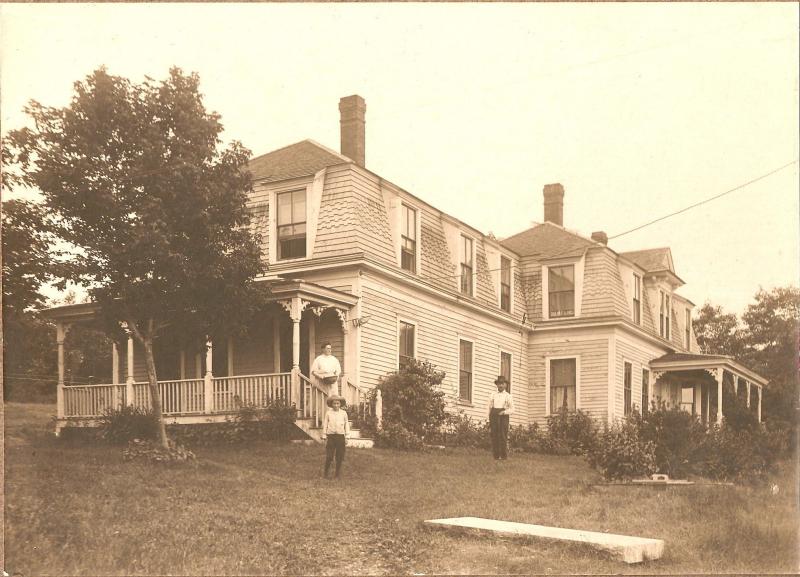The Andersen House in East Boothbay, Part III
These articles have covered the Andersen house site on the corner of Route 96 and Andersen Road, including the houses that have been on it and the people who lived there. After Boothbay was permanently resettled in 1730, there was a log house on the property by 1772. In 1834 a conventional cape was built which was eventually greatly expanded with the additions of an ell and another cape. Two different families owned the place until 1853 when it went to Miles Hagan. It stayed in his extended family for nearly 100 years. His daughter Rinda and son-in-law, James Oliver Seavey, took over the house in 1868. James Oliver, as he was called, was a Civil War veteran and was a pumpmaker and blockmaker for the village shipyards.
Cape to Mansard
It was probably in the 1880s that Rinda and James Oliver took their two connected capes and had them transformed into a mansard-roofed house. At least those dates bracket the mansard style houses in the village, all whose building dates I know. The first and most ornate is on the west corner of Green Landing Road, built in 1879 by James Oliver's uncle, Charles Seavey. Perhaps Charles, before his death in 1889, built James Oliver’s house. The two McDougall stores, kitty-corner to each other near Lincoln Street, went up in 1886; the present post office is the surviving one. The corner store was started in 1890 by Charles's son, Frank Seavey. And the Citizens Union (C.U.) Hall next to the mill pond, built in 1890, was the biggest — burnt by an arsonist in the early 1980s.
I couldn't watch key moments during the demolition of the Andersen house, but Brian Merrill, the new owner, assured me my assumption was correct—that the second story of the cape was removed and was rebuilt in the mansard configuration. That gave those upstairs the ability to stand up anywhere. So — timber framing below, smaller dimension lumber above. James Oliver and Rinda didn't lack for room with only two children, Miles and Annie, but maybe they wanted to have more convenience and get with the times.
Family continuity
Most region land or house transfers in the 1700s and 1800s were within families unless the families ran out of members. And that was mostly true of this house after 1853 and before the late 1950s Andersen owners. Over 100 years it went from father to daughter to grandson and great grandson in the old pattern of continuity. From James Oliver and Rinda, who died in the 1920s, the house went to their son Miles Seavey, a fine shipyard rigger, colorful and well-liked in the village, and single all his life. His sister Annie married Philip Murray, and their son Kenneth, also known as Tessie, moved into Miles's house with his wife. It remained a double house for decades with both related families living there, a very common arrangement formerly.
Elise Andersen remembered that the house was lost for taxes in the 1950s before her family bought it in 1958. It was a common fate for the elderly in town to “go on the town,” after losing all their assets, common before F.D.R. introduced Social Security but well afterward too as seen here. To go on the town meant you were penniless, or “pauperized,” and supported by the town. Sometimes the town allowed paupers to stay in their homes, or they went to the town farm with others who’d fallen on hard times, or they were bid off to the lowest bidder who provided room and board. The federal government has taken over much of that burden.
And sure enough, the house was in the unpaid tax columns of Miles Seavey (until his 1949 death) and Tessie Murray in the town reports from 1948 to 1953. I remember Tessie as an elderly man walking the village roads; he lived in a little place in the woods not far from his old house, north of Mike Pare's shop on Route 96. The town acquired the house in 1954 and eventually sold it to Weston Andersen and his family in 1958. That artistic family was in residence there for nearly 60 years.
It's too bad to have the old village landmark gone, but as new owner Brian got into the process of restoring it, reasons mounted to stop trying to save it. For those mystified as to where the Andersen Design shop and showroom has gone, they're at 157 River Road in Edgecomb. June and Bob Rose have provided space for their stoneware pieces in their gallery, "Above and Beyond." Baby seals are still here — just down the road.





























